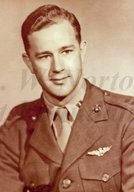
|

|
|
|
|
Floyd was born in Shreveport to Jessie S. Earnest, a railroad engineer, and Eudora "Lovie" Bishop Earnest. He graduated from Byrd High School in 1940, and went to work in the kitchen for Texas Oil Company, washing dishes and serving food to crews. He was attending Centenary College and taking aviation courses when America entered World War II. He completed primary and secondary pilot training by May of 1942, then enlisted in the U.S. Navy as an aviation cadet and started flight training on July 15, 1942 in New Orleans. After three months Floyd was sent to Pensacola, where he completed training in an accelerated program, and was commissioned a 2nd Lieutenant in the U.S. Marine Corps on April 1, 1943. At the U.S. Marine Corps Air Station at Cherry Point, North Carolina he was assigned to a night fighter squadron, VMF (N)-532. There he also trained in the F-4U Corsair. "I loved to fly it," he recalls of the famous airplane. He took advanced fighter squadron training in Jacksonville, Florida, then, at Glenview Naval Air Station in Glenview, Illinois, trained in take-offs and landings in the F-4F Hellcat on the carrier USS Sable (IX-81). Floyd was sent overseas with his squadron and served at duty stations on Tarawa, Kwajalein, and an island near Eniwetok. With orders to return to the States he reported to US Marine Corps Air Station at Eagle Mountain Lake, Texas, where, from December of 1944 to July of 1945, he trained night fighter pilots, using F-6F fighter planes. In his second tour of duty overseas he was sent to train night fighter pilots in the Philippines. Floyd was on Okinawa picking up a new plane when Japan surrendered. Around October of 1945, he recalls, his squadron was ordered to Peking, China. There he flew railroad patrol, guarding tracks against destruction by Communist forces of Mao Tse-tung. He recalls relations between US military personnel and Peking citizens as "very good". Floyd applied for and was granted a regular commission, changing his designation from a lieutenant in the US Marine Corps Reserves to a lieutenant in the US Marine Corps. He was based in Pensacola for two years where he was senior shore patrol officer and "officer in charge" of a cadet battalion. A month before he left for Korea in 1952 he married Joan E. Cardone, a navy nurse. (They would have three children and four grandchildren.) He spent a year in Korea, again in night fighters, and flying the F-7F in bombing targets along the Main Line of Resistance between American and Chinese forces. He returned home in the summer of 1953, and re-trained in helicopters at Naval Air Station in Pensacola. He spent about seven years as a helicopter pilot. After Joan passed away, Floyd married Lena Bagley, a widow with two children, in December of 1955. He was stationed in Spain before returning to the States in 1960. He retired as a major in 1963 at Camp Lejeune in Jacksonville, North Carolina. He enrolled at Oklahoma State University in education, and after finishing, taught school in Shreveport for five years. Floyd then worked as a revenue deputy for Louisiana Department of Revenue for 13 years. |


